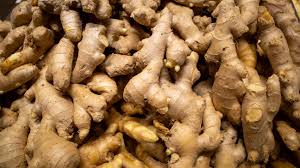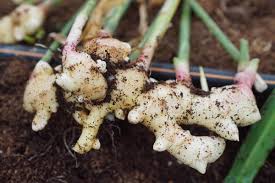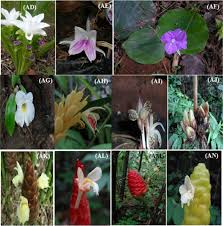Zingiberaceae (700 sp.). Leaves distichous, sheathing, and with a distinct ligule. Perianth of 6 segments in 2 whorls, generally distinguishable into calyx and corolla.
Stamens in 2 whorls only 1 perfect, adnate to corolla-throat (this is the posterior one of the inner whorl), the other 2 stamens of this whorl are united to form a 2-lipped labellum; the anterior stamen of the outer whorl is absent and the remaining 2 modified into petaloid staminodes or absent.
Style slender, passing through the two anther-lobes. Floral formula—⚥K(3)C3A1G(3). Examples: Zingiber (80 sp.), e.g., ginger (Zingiber officinale), wild ginger (Z. casumunar).
Turmeric (Curcuma longa), wild turmeric (C. aromatica), mango ginger (C. amada), butterfly lily (Hedychium coronarium; B. DULAL-CHAMPA), Kaempferia, e.g., K. rotunda (B. BHUI-CHAMPA).
Costus (150 sp.), C. speciosus (B. KUST; H. KEU), Alpinia (225 sp.), e.g., A. allughas (B. TARA), A. galanga medicinal, Globba (100 sp.), e.g., G. bulbifera.
Read Also: Blackleg (cruciferous plants): Description, Damages Caused, Control and Preventive Measures
Economic and Culinary Importance of Ginger (Zingiber officinale)

Ginger originated in tropical Asia but is now grown all over the tropics. West Africa is an important exporter of the crop, Sierra Leone being the leading producer.
Ginger has a variety of uses as a spice in cooking, and in the preparation of confectioneries, pickles, and beverages such as ginger ale.
It is used in Sierra Leone and Liberia to make ginger beer, and as a preparation for stomach disorders.
Climatic and Soil Requirements for Ginger Cultivation
It grows best in lowland forest areas, under shade. The rainfall should be heavy (2,000-2,500 mm), but it does well under light, well-distributed rainfall of 780-1,000 mm if irrigated. The soil should be a deep loam, rich in humus, and well-drained.
Ginger Varieties Grown in West Africa
The most popular and recommended variety in Sierra Leone is the Yellow type.
Read Also: 17 Medicinal Health Benefits Of Lotus Seed (Nelumbo nucifera)
Cultivation Practices for Ginger in West Africa

It is propagated by pieces of rhizomes 2.5-5 cm long containing one or two eyes. They are planted in holes 5-7.5 cm deep and 30-45 cm apart. Planting is done in March or April.
The rhizomes sprout and appear above the ground 10-15 days after planting. It benefits from weeding and manuring. Fertilizer is applied before planting or at the beginning of the rainy season.
The plant matures in 9–10 months, and the rhizomes are harvested when the leaves turn yellow and wither.
In Sierra Leone, the rhizomes are carefully lifted to avoid bruising and these are washed in water and then peeled with specially designed spoon-like knives.
Peeling of ginger is a skilled job, otherwise the skin containing the volatile oil upon which the aroma and flavor depends may be injured.
The peeled ginger hands are washed again and sun-dried for 6–8 days on concrete floors or on palm fronds until the moisture content is reduced to 7-12 percent.
This helps them to maintain their white color. During drying, the hands are turned over at about mid-day, and they are taken indoors in the evening.
In Nigeria, ginger is more often split than peeled, although this fetches far less money.
Yield Potential of Ginger in Sierra Leone
An average yield of 750 kg per ha is obtained in Sierra Leone. The potential of the best variety is 2,241 kg cured ginger per ha per annum. Four tonnes of rhizome will give one tonne of sun-dried ginger.
Diseases Affecting Ginger Crops
Black rot: The leaves of diseased plants turn yellow and wither, and the rhizome disintegrates. The disease is common under wet conditions.
Control is achieved by removing infected plants and treating the soil with lime or sulphate of iron.
Vermicularia zingiberae: This disease affects the leaves and prevents rhizome development. Spraying with Bordeaux mixture gives effective control.
Do you have any questions, suggestions, or contributions? If so, please feel free to use the comment box below to share your thoughts. We also encourage you to kindly share this information with others who might benefit from it. Since we can’t reach everyone at once, we truly appreciate your help in spreading the word. Thank you so much for your support and for sharing!

